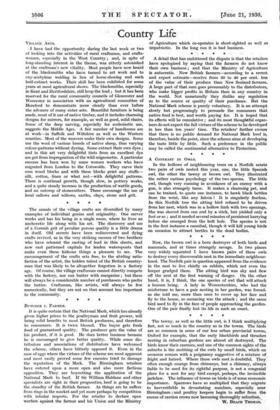Country Life
VILLAGE ARTS.
-, I. have had the opportunity -during the last week or two of looking into the activities of rural craftsmen, and crafts- women, especially, in the West Country ; and, in spite of long-standing interest in the theme, was utterly, astonished at the craftman's new vitality. Most people have now heard pf the blacksmiths who have turned to art work and to oxy-acetylene welding in lieu of horse-shoeing and such half-extinct works. Their skill has been exhibited for some years at most agricultural shows. The blacksmiths, especially in Kent -and Hertfordshire, still keep the lead ; but it has been reserved for the rural community councils of Gloucester and Worcester in association with an agricultural committee of Hereford to demonstrate more clearly than ever before the advance of many sister arts. Beautiful furniture is being made, most of it out of native timber, and it includes charming designs for mirrors, for example, as well as good, solid chairs, Some of the deep carving, especially for ecclesiastic use, suggests the Middle Ages. A fair number of handlooms are at work—in Suffolk and Wiltshire as well as the Western counties. Most of the weavers make their own designs. Some use the wool of various breeds of native sheep, thus varying colour-patterns without dyeing, Some extract their own dyes ; and in this art very delightful tints from an excellent dye are got from impregnation of the wild mignonette. A particular success has been won by some women workers who have migrated from London to the Cotswolds. They carve their own wood blocks and with these blocks print any stuffs— silk, cotton, linen or what not—with delightful patterns. There is continual growth, though slow, in pottery works, and a quite steady increase in the production, of wattle goods, and an outcrop of stonecutters. These encourage the use of local sallows and willows, earths, days, stone and grit.
* * * *








































 Previous page
Previous page